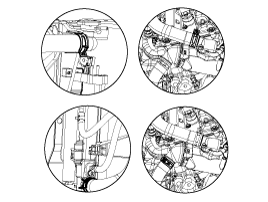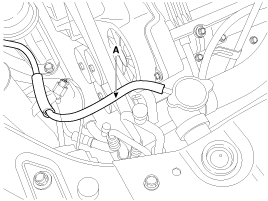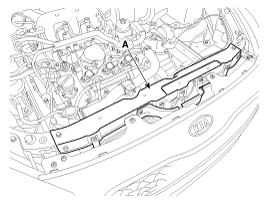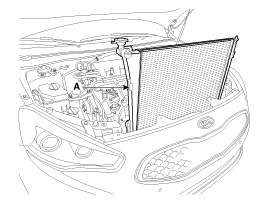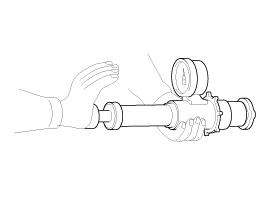Kia Cadenza: Cooling System / Radiator Repair procedures
Kia Cadenza YG 2016-2025 Service Manual / Engine Mechanical System / Cooling System / Radiator Repair procedures
| Removal and Installaton |
| 1. |
Remove the engine room under cover.
(Refer to Engine And Transaxle Assembly - “Engine Room Under Cover”) |
| 2. |
Drain the coolant.
(Refer to Cooling System - “Coolant”) |
| 3. |
Remove the radiator upper hose (A) and lower hose (B).
|
| 4. |
Disconnect the ATF cooler hoses.
(Refer to Automatic Transaxle System - "Automatic Transaxle") |
| 5. |
Remove the radiator grill upper guard (A).
|
| 6. |
Disconnect the over flow hose (A).
|
| 7. |
Remove the radiator upper mounting bracket assembly (A).
|
| 8. |
Separate the condenser from the radiator and then pull radiator (A) up and remove it from engine room.
|
| 9. |
Fill the radiator with coolant and check for leaks.
|
| Inspection |
Radiator Cap Testing
| 1. |
Remove the radiator cap, wet its seal with engine coolant, and then install it on a pressure tester.
|
| 2. |
Apply a pressure of 93.16 ~ 122.58kpa (0.95 ~ 1.25kg/cm², 13.51 ~ 17.78psi). |
| 3. |
Check for a drop in pressure. |
| 4. |
If the pressure drops, replace the cap. |
Radiator Leakage Test
| 1. |
Wait until engine is cool, then carefully remove the radiator
cap and fill the radiator with engine coolant, then install it on the
pressure tester. |
| 2. |
Apply a pressure tester to the radiator and apply a pressure of 93.16 ~ 122.58kpa (0.95 ~ 1.25kg/cm², 13.51 ~ 17.78psi). |
| 3. |
Inspect for engine coolant leaks and a drop in pressure. |
| 4. |
Remove the tester and reinstall the radiator cap.
|
 Radiator Components and Components Location
Radiator Components and Components Location
Components
1. Radiator2. Mounting insulator3. Radiator upper hose4. Radiator lower hose5. Coolant reservoir tank6. Over flow hose7. ATF cooler hose
...
 Reservoir Tank Repair procedures
Reservoir Tank Repair procedures
Removal and Installation
1.
Disconnect the over flow hose (A), and then remove the resorvior tank (B).
Tightening torque:
3.9 ~ 5.9 N.m (0.4 ~ 0.6 kgf.m, 2.9 ~ 4.3 lb-ft)
2.
Installation ...
Other information:
Kia Cadenza YG 2016-2025 Service Manual: Specifications
Specification ItemTypeWattage (W)FrontHead lamp (High)H965Head lamp (Low)H7/ D1S (HID)55/ 35(HID)Front turn signal lampPY28/828WPosition lampLEDLEDSide repeater lamp (Outside mirror)LEDLEDFront fog lampGeneralH835LEDLEDLEDRearStop and tail lampLEDLEDRear turn signal lampPY2727WBack-up lampW16W1 ...
Kia Cadenza YG 2016-2025 Owners Manual: Electrical Equipment (U.S. only)
The electrical system of your vehicle is designed to perform under all reasonably expected operating conditions. However, before any additional electrical equipment is installed in your vehicle, consult an Authorized Kia Dealer, in order to ensure that you do not void your warranty. Certain ...
Copyright © www.kcadenzavg.com 2017-2025




